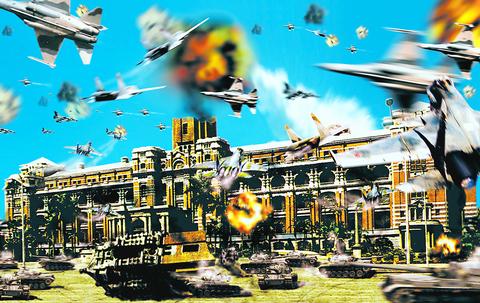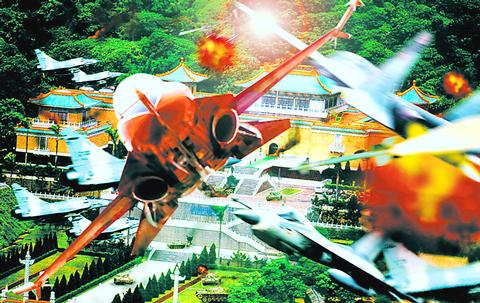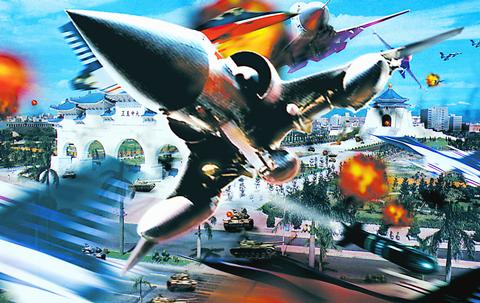In an address made on June 16 of last year, President Chen Shui-bian (陳水扁) commented on the possibilities of navel engagement with the Peoples Liberation Army (PLA) in the Taiwan Strait. His comments were met with incredulity by many in the military and sent shivers down the spines of ordinary citizens.
While the possibility of such an offshore engagement is not something that instantly lends itself to humor, several local artists have joined together in order to take a collective, sarcastic and off-the-wall look at the possibilities of such an event.

PHOTO: CHERNG PIIN GALLERY
Entitled Iconoclasm to Neo-Iconolatry, the exhibition at the Cherng Piin Gallery sees works by seven artists tackling the issue of war with China and deterioration of society in general.

PHOTO COURTESY OF CHERNG PIIN GALLERY
The most prominent of the works on display is by Mei Dean-E (梅丁衍). Returning from the US in 1991 after three years studying Chinese art history under Professor James Cahill at Berkeley, Mei's memories of the post-martial law era in Taiwan remain vivid. Recalling that period today, Mei refers to it as "the era in which everything was deconstructed."
And indeed, deconstruction plays a big part in his latest work. Titled Offshore Engagement (境外決戰), the work depicts jet fighters and bombers attacking four of Taiwan's better known landmarks. The National Palace Museum, the Presidential Office, the Grand Hotel and the Chiang Kai-shek Memorial Hall Plaza, all pictured being unceremoniously leveled by squadrons of the People's Liberation Airforce.

PHOTO: CHERNG PIIN GALLERY
Through the use of computer generated and composite graphics, Mei has created a world that on the outside might appear to be the stuff of nightmares, but within the bombs and chaos lies sarcasm of the blackest variety. Like many, Mei feels the chances of a major naval conflict with China actually taking place are laughable.

PHOTO COURTESY OF CHERNG PIIN GALLERY
This point is echoed by art critic and curator of the exhibition Jason Wang (王嘉驥), who, while not voicing his opinion on matters of national defense, does feel that the post-martial law era has seen a marked rise in the challenging of authority through the defamation of once sacred political and cultural icons.
Needless to say, deconstruction of such icons features largely in the exhibition. While Mei may be the only artist who dares to level the Presidential Office, the tongue-in-cheek concepts of annihilation and devastation take many forms: such as the comic belittlement of one of the nation's lesser known tourist spots.
Well-known for his Recover the Mainland series, in which he superimposed his own photographic image into shots of several of China's leading tourist attractions, Yao Jui-chung (姚瑞中) has chosen an unusual ally in order to help him tackle the issue of destruction and armed conflict.
With the help of The Little Mermaid and an amusement park located in northern Taiwan, Yao ridicules true love in a commercial world that could come to an untimely and bloody end. The angelic aquatic mermaid is pictured rotting amid the ruins of the devastated amusement park.
Unlike Mei and Yao, artist Hung Tung-lu (洪東祿) has addressed the issue of decimation and defamation without the devastation. Hung isn't going to war with the PLA and is instead making viewers ponder social deterioration and changing values.
With the help of a host of Japanese cartoon characters including Street-Fighter, Chun-li, Sailor Moon, Lynn Minmay, and Evangelion Ayanami Rei, Hung makes viewers look twice at images normally taken for granted.
Slightly altered images of these X-Gen cultural icons have been superimposed over pictures of temples. Hung sees this as indicative of how mass produced items have replaced once solid religious values and truths.
There are contributions from four other artists, all of whom have their own highly personal styles. Works by Chen Chieh-jen (陳界仁), Lin Ju (林鉅), Hsia Yan (夏陽) and Kuo Chen-chang (郭振昌) may not be as hard hitting as those by the other artists, but they remain as sarcastic and as poignant as those of their peers.
Although From Iconoclasm to Neo-Iconolatry is not an exhibition that will appeal to all art lovers, those who enjoy black humor will find something to amuse themselves amongst the exhibits.
Art Notes:
What: rom Iconoclasm to Neo-Iconolatry (從反聖像到新聖像)
Where: Cherng Piin Gallery (誠品畫廊), B2, 245, Sec. 1, Tunhua S. Rd., Taipei (台北市敦化南路一段245號B2)
When: Until June 17

In the March 9 edition of the Taipei Times a piece by Ninon Godefroy ran with the headine “The quiet, gentle rhythm of Taiwan.” It started with the line “Taiwan is a small, humble place. There is no Eiffel Tower, no pyramids — no singular attraction that draws the world’s attention.” I laughed out loud at that. This was out of no disrespect for the author or the piece, which made some interesting analogies and good points about how both Din Tai Fung’s and Taiwan Semiconductor Manufacturing Co’s (TSMC, 台積電) meticulous attention to detail and quality are not quite up to

April 21 to April 27 Hsieh Er’s (謝娥) political fortunes were rising fast after she got out of jail and joined the Chinese Nationalist Party (KMT) in December 1945. Not only did she hold key positions in various committees, she was elected the only woman on the Taipei City Council and headed to Nanjing in 1946 as the sole Taiwanese female representative to the National Constituent Assembly. With the support of first lady Soong May-ling (宋美齡), she started the Taipei Women’s Association and Taiwan Provincial Women’s Association, where she

Chinese Nationalist Party (KMT) Chairman Eric Chu (朱立倫) hatched a bold plan to charge forward and seize the initiative when he held a protest in front of the Taipei City Prosecutors’ Office. Though risky, because illegal, its success would help tackle at least six problems facing both himself and the KMT. What he did not see coming was Taipei Mayor Chiang Wan-an (將萬安) tripping him up out of the gate. In spite of Chu being the most consequential and successful KMT chairman since the early 2010s — arguably saving the party from financial ruin and restoring its electoral viability —

It is one of the more remarkable facts of Taiwan history that it was never occupied or claimed by any of the numerous kingdoms of southern China — Han or otherwise — that lay just across the water from it. None of their brilliant ministers ever discovered that Taiwan was a “core interest” of the state whose annexation was “inevitable.” As Paul Kua notes in an excellent monograph laying out how the Portuguese gave Taiwan the name “Formosa,” the first Europeans to express an interest in occupying Taiwan were the Spanish. Tonio Andrade in his seminal work, How Taiwan Became Chinese,